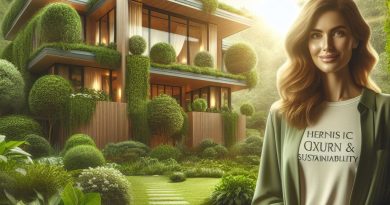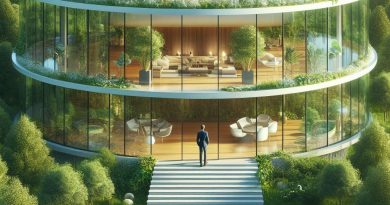Sustainable Splendor: Green Luxury Realities
Last Updated on March 11, 2024
Introduction
In the ever-evolving realm of real estate, a new paradigm is emerging—one where opulence seamlessly intertwines with environmental responsibility.
Welcome to the era of “Sustainable Splendor: Green Luxury Realities.” As concerns about climate change escalate and environmental consciousness deepens, the demand for eco-friendly properties is experiencing an unprecedented surge.
In this post, we embark on a journey into the world of sustainable luxury real estate.
We delve into the motivations driving individuals to seek eco-friendly havens and explore the innovative solutions that architects, developers, and homeowners are embracing to create residences that are as luxurious as they are environmentally responsible.
The global shift towards sustainability is reshaping the real estate landscape.
Discerning buyers now view opulent living through a green lens, valuing properties that minimize their ecological footprint.
Sustainable luxury real estate is not merely a trend; it’s a reflection of a conscientious lifestyle.
As urban jungles expand, there’s a growing desire to reconnect with nature without sacrificing the luxuries of modern living.
Sustainable luxury residences are answering this call, providing homeowners with a harmonious blend of sophistication and environmental mindfulness.
Rooftop gardens, energy-efficient systems, and eco-friendly materials are becoming defining features of these residences.
What is Sustainable Luxury Real Estate?
Sustainable luxury real estate refers to properties that combine luxurious features with environmentally friendly practices.
These properties are designed to blend opulence with sustainability, offering a unique and upscale living experience.
The Concept of Sustainable Luxury Real Estate
Sustainable luxury real estate is all about finding a harmonious balance between indulgence and eco-consciousness.
It involves integrating high-end amenities and finishes with sustainable materials and energy-efficient systems.
By doing so, these properties reduce their carbon footprint while still offering a luxurious lifestyle.
The Integration of Luxury Features with Environmentally Friendly Practices
In sustainable luxury real estate, every aspect is thoughtfully curated to ensure a minimal impact on the environment.
This includes the use of renewable materials such as bamboo flooring or reclaimed wood in construction and incorporating smart home technology to optimize energy consumption.
Additionally, solar panels and geothermal heating systems are often installed to minimize reliance on traditional energy sources.
Benefits and Characteristics of Sustainable Luxury Properties
Environmental Impact
Sustainable luxury properties significantly reduce environmental impact by utilizing renewable resources and minimizing energy consumption.
They contribute to a cleaner and greener future.
Energy Efficiency
These properties are designed to be highly energy-efficient, resulting in lower utility bills and reduced carbon emissions.
Energy-saving features such as LED lighting and energy-efficient appliances are commonly found.
Health and Well-being
Sustainable luxury properties prioritize occupant health and well-being.
They often incorporate natural and non-toxic materials, improving indoor air quality.
Spaces are designed for optimal natural light and airflow, promoting a healthy living environment.
Innovation and Technology
By integrating cutting-edge technology, sustainable luxury properties offer state-of-the-art living experiences.
Smart home systems allow residents to control and monitor energy usage, enhance security, and customize their living spaces.
Exclusivity and Prestige
Owning a sustainable luxury property offers a sense of exclusivity and prestige.
These properties are highly sought-after by environmentally conscious individuals who value both luxury and sustainable living.
Long-Term Investment
Investing in sustainable luxury real estate proves to be a wise choice.
The demand for eco-friendly properties is increasing, making them a valuable asset in the long run.
Community Enhancement
Sustainable luxury developments often contribute positively to the surrounding community.
They may include green spaces, nature conservation initiatives, or community engagement programs, exemplifying responsible development practices.
Unique Aesthetic Appeal
Sustainable luxury properties stand out with their unique aesthetic appeal.
The combination of high-end design, eco-friendly materials, and lush surrounding landscapes creates a visually stunning living space.
In short, sustainable luxury real estate offers a new paradigm where opulence and eco-consciousness are seamlessly integrated.
These properties promote a luxurious lifestyle while demonstrating a commitment to environmental responsibility.
With their numerous benefits and characteristics, sustainable luxury properties are redefining the standard for upscale living.
Read: Opulent Lighting: Trends in Luxury Spaces
Current Trends in Sustainable Luxury Real Estate
In recent years, there has been a significant shift in the real estate industry towards sustainable luxury properties.
This growing interest is fueled by a desire to protect the environment, promote energy efficiency, and embrace eco-friendly practices.
Here are some key trends shaping the world of sustainable luxury real estate:
Sustainable Design, Materials, and Technologies
- Sustainable luxury real estate emphasizes the use of environmentally-friendly design principles.
- Builders and architects are incorporating renewable materials such as bamboo, reclaimed wood, and recycled glass.
- Cutting-edge technologies like solar panels, geothermal heating, and advanced insulation systems are utilized.
- These features not only reduce carbon footprint but also enhance the overall efficiency and comfort of the properties.
Energy Efficiency, Renewable Energy Sources, and Water Conservation
- Energy efficiency is a top priority for sustainable luxury real estate.
- High-performance appliances, LED lighting, and smart thermostats help minimize energy consumption.
- Renewable energy sources such as solar, wind, and hydropower are integrated into property designs.
- Water conservation techniques like rainwater harvesting and graywater recycling systems are implemented.
Use of Recycled Materials and Eco-friendly Building Practices
- Builders are increasingly incorporating recycled and salvaged materials into luxury properties.
- Reclaimed bricks, repurposed wood, and recycled steel are used in construction.
- Efforts are made to reduce waste by implementing sustainable building practices.
- These initiatives aim to minimize the impact on the environment while maintaining the luxurious nature of the properties.
Incorporation of Smart Home Technology and Sustainable Landscaping
- Smart home technology enables homeowners to monitor and control energy usage through automation systems.
- Advanced security systems, energy-efficient lighting, and automated thermostats are common features.
- Sustainable landscaping focuses on native plants, water-efficient irrigation, and natural drainage systems.
- Green roofs and vertical gardens are also popular, providing aesthetic appeal and environmental benefits.
In essence, sustainable luxury real estate is a rapidly growing sector that integrates eco-friendly practices and technologies into high-end properties.
From sustainable design and energy efficiency to the use of recycled materials and smart home technology, these trends are reshaping the definition of luxury living.
As more buyers prioritize sustainability, the demand for green luxury homes will continue to rise, pushing the industry towards a more environmentally-conscious future.
Read: Elegant Eco Estates: Where Luxury Goes Green

Examples of Sustainable Luxury Real Estate Projects
When it comes to luxury real estate, many people envision lavish homes with no regard for the environment.
However, there is a growing trend towards sustainable luxury, where developers prioritize eco-friendly practices without compromising on elegance and opulence.
Here are some notable sustainable luxury real estate projects that exemplify this balance:
The Edge, Amsterdam
The Edge, located in Amsterdam, is not only one of the most sustainable buildings in the world but also a stunning display of luxury.
This innovative office building features a combination of cutting-edge technologies, including solar panels, rainwater harvesting systems, and energy-efficient LED lighting.
Central to its sustainability goals is the building’s ability to generate more energy than it consumes.
Designed to accommodate over 2,500 employees, The Edge utilizes smart sensors to optimize energy usage and provides occupants with a comfortable and stylish working environment.
One Central Park, Sydney
One Central Park in Sydney, Australia, is a prime example of how luxury and sustainability can coexist harmoniously.
Developed by Jean Nouvel and Patrick Blanc, this residential complex boasts vertical gardens that span several floors, providing residents with a lush, green living environment in the heart of the city.
The building’s sustainable features include a tri-generation plant that generates electricity, heating, and cooling.
Additionally, the incorporation of natural lighting and passive ventilation systems minimizes energy consumption and enhances the overall comfort of residents.
The Bullitt Center, Seattle
The Bullitt Center in Seattle is a game-changer in terms of sustainable commercial real estate.
This six-story office building demonstrates the potential for net-zero energy consumption, as it generates all of its energy from renewable sources.
Featuring a rooftop solar panel array, rainwater collection system, and composting toilets, The Bullitt Center showcases how sustainable design can be both functional and aesthetically pleasing.
Its open, well-lit, and collaborative spaces create a desirable work environment while reducing the building’s environmental impact.
The Solaire, New York City
The Solaire, located in the Battery Park City neighborhood of New York City, was the first green residential building in the United States.
This luxury high-rise sets the benchmark for sustainable living with its use of solar panels, advanced insulation, and energy-efficient appliances.
Its sustainable practices extend beyond energy conservation.
The Solaire also emphasizes residents’ health and well-being by incorporating green spaces, eco-friendly cleaning products, and using low volatile organic compound (VOC) materials throughout the building.
The Crystal, London
The Crystal in London is a sustainable events venue and exhibition center that showcases the future of sustainable design.
This iconic structure boasts numerous eco-friendly features, including rainwater harvesting, greywater recycling, and solar power generation.
As an educational hub, The Crystal strives to inspire visitors with its interactive exhibitions on sustainable development and innovations.
It serves as a testament to how even large-scale developments can incorporate sustainable practices without compromising design or functionality.
These examples demonstrate that luxury and sustainability can coexist in the world of real estate.
By embracing eco-friendly technologies and practices, these projects are pushing the boundaries of what is possible in creating a truly sustainable and luxurious living environment.
As sustainable luxury becomes an increasingly influential trend, it is essential for the real estate industry to prioritize environmentally-conscious design and construction techniques.
Only then can we ensure a sustainable future that combines both splendor and responsibility.
Read: Artistic Flair in High-End Design of 2024
The market for sustainable luxury real estate
In the ever-evolving landscape of real estate, a new paradigm is emerging – one that marries opulence with responsibility.
The demand for sustainable luxury properties in the market
The market for sustainable luxury real estate is not just a trend; it is a seismic shift towards conscientious living.
Analyzing the demand for such properties reveals a resounding resonance among discerning buyers who seek not just lavish living spaces but also a commitment to environmental stewardship.
The motivations of buyers and investors in this niche
Buyers and investors in the sustainable luxury niche are motivated by a unique set of values.
Beyond the allure of exquisite design and premium amenities, these individuals are driven by a desire to make a positive impact.
The eco-conscious consumer is no longer satisfied with merely minimizing their carbon footprint; they demand residences that actively contribute to sustainability.
Green building materials, energy-efficient systems, and eco-friendly landscaping have become pivotal factors in decision-making, transforming luxury real estate into a showcase of responsible living.
The economic viability of sustainable luxury real estate is a beacon of hope for the environmentally conscious investor.
As governments worldwide enact stringent environmental regulations, the value of green properties is set to soar.
Sustainable features not only attract a premium in the market but also result in long-term cost savings for homeowners.
Energy-efficient technologies, coupled with the growing availability of renewable energy sources, make these properties not just environmentally friendly but economically savvy investments.
The economic viability and potential for growth in this sector
The potential for growth in this sector is nothing short of remarkable.
As sustainability becomes a core consideration in lifestyle choices, the demand for green luxury properties is expected to surge.
Developers and investors who embrace this shift stand to gain not only financially but also in reputation.
The marriage of luxury and sustainability is not just a market niche; it’s a glimpse into the future where elegance coexists harmoniously with environmental responsibility.
Basically, the market for sustainable luxury real estate is not a fleeting trend but a profound transformation in the real estate landscape.
The demand is fueled by conscious consumers seeking more than just material indulgence.
With economic benefits and substantial growth potential, the green luxury sector is proving that opulence can indeed be sustainable, ushering in a new era of responsible living.
Read: Minimalist Elegance in Modern Luxury Homes
See Related Content: The Rise of Luxury Condos in Major Cities
See Related Content: Touring America’s Most Expensive Homes
Challenges and considerations in sustainable luxury real estate
In the pursuit of creating a harmonious blend of opulence and eco-consciousness, developers in the realm of sustainable luxury real estate encounter an array of challenges that demand ingenuity and perseverance.
Chief among these hurdles is the delicate dance between high-end aesthetics and environmentally responsible construction.
The obstacles and challenges developers face in implementing sustainable practices
Implementing sustainable practices in luxury real estate often grapples with the inherent tension between architectural grandeur and ecological sensitivity.
Developers face the challenge of sourcing materials that meet both aesthetic standards and eco-friendly criteria, a task that demands meticulous research and collaboration with innovative suppliers.
Striking the right balance becomes pivotal, as the essence of luxury must not compromise the commitment to sustainability.
The cost aspects associated with sustainable design and technology
However, the journey towards a greener future is not without its financial considerations.
Sustainable design and cutting-edge technology often come with an initial cost premium.
Developers must navigate the terrain of balancing the allure of sustainability with the bottom line.
While upfront expenses may be higher, the long-term benefits in energy efficiency and resource conservation often outweigh these initial investments.
The challenge lies in convincing stakeholders to view sustainability as a wise and forward-thinking investment rather than a mere expense.
The need for educating buyers and agents about the benefits and value of sustainable luxury real estate
Education emerges as a cornerstone in this paradigm shift towards sustainable luxury.
Buyers and real estate agents must be enlightened about the manifold advantages of choosing eco-friendly properties.
It’s not merely a trend but a commitment to a lifestyle that resonates with responsible stewardship.
Developers need to lead the charge in educating all stakeholders about the value of sustainable luxury real estate, fostering a mindset that appreciates the long-term benefits for both the individual and the planet.
In the pursuit of creating sustainable splendor, developers find themselves at the intersection of innovation and responsibility.
Overcoming challenges in material selection, navigating cost considerations, and fostering awareness are integral steps toward ushering in a new era where luxury seamlessly integrates with a commitment to a greener, more sustainable future.
Conclusion
In the journey through “Sustainable Splendor: Green Luxury Realities,” we’ve explored the evolving landscape of luxury real estate, discovering a harmonious intersection between opulence and environmental responsibility.
In essence, we’ve witnessed a paradigm shift in the perception of luxury, with sustainability emerging as the defining trait of modern opulence.
The blog delved into the innovative technologies and eco-friendly practices transforming the sector, showcasing how green features seamlessly integrate with extravagant designs to create truly exceptional homes.
Our exploration began with a revelation: sustainable luxury is not a mere trend but a conscientious choice shaping the future of real estate.
The incorporation of solar panels, energy-efficient appliances, and eco-friendly building materials is not just a nod to environmental concerns; it is an investment in a better, greener tomorrow.
The juxtaposition of sustainability and grandeur challenges the conventional notion that opulence must come at the cost of the planet.
As we navigated through examples of LEED-certified mansions and carbon-neutral retreats, it became evident that these properties are not only reducing their ecological footprint but also increasing in desirability.
Forward-thinking buyers are recognizing the intrinsic value of owning a home that not only reflects their affluence but also their commitment to a sustainable lifestyle
In the final call to action, we encourage readers to consider the plethora of sustainable options available in the luxury real estate market.
The appeal of living in a home that epitomizes both grandeur and environmental responsibility is no longer a distant dream but a tangible reality.
As consumers, we wield significant influence in shaping industries; let’s use that power to foster a future where sustainable splendor reigns supreme in the world of luxury real estate.


